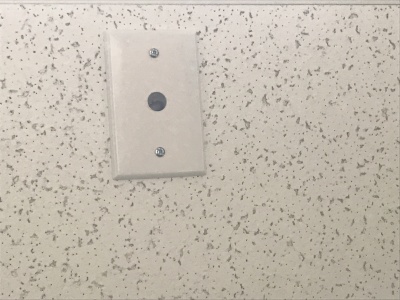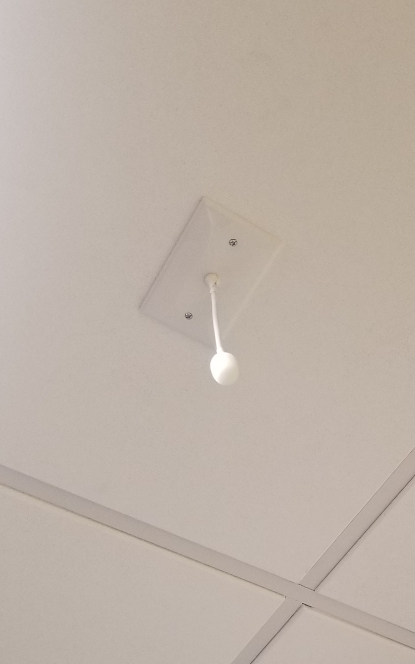Installing an Axis V5914/V5915 with a Sure MX202i Microphone (No Preamp)
Contents
Required Parts And Tools
- Axis V5914/V5915
- Shure MX202i Microphone
- 1/2" paddle bit
- 1 blank single gang wall plate
- Toggle Bolts (If mounting to drop ceiling tile) (3/16")
- Tap-Cons (if mounting to concrete) (3/16")
- Screws and Anchors (3/16")
- Drill bit and drill
- Phillips head drill bit or Phillips head screwdriver
- Small Flat head screwdriver
- Hole Saw (2")
- B Connectors
- Cat5/6 Patch Cable (7ft-15ft recommended)
- Shielded Stranded 22/2 + ground Wire
- Fish Tape or Glow Rods
- Wind Screen (Inside MX202i kit)
- Rubber Stopper (Inside MX202i kit)
- 4 pin XLR-M to XLR-M Adapter (Inside MX202i kit)
Installation Instructions
Drop Ceiling Mount Instructions
NOTICE: The combined weight of the camera and mounting bracket is approximately 1.7 kg (3.7 lb.). Make sure that the ceiling material is strong enough to support this weight. The ceiling tile should be 5–60mm (0.2–2.4in.) thick.
- Locate the network drop above the ceiling either being a male Ethernet end (service loop) or a biscuit jack. This will have been ran back to the POE switch.
- Note: If the switch does not have POE, a POE injector will need to be installed at the network closet.
- Remove the ceiling tile in which the drop ceiling mount is to be fitted.
- Drill a 7 mm (9/32 in) hole in the ceiling tile.
- Drill about a 1" hole where the cables will pass through into the ceiling.
- Remove the tripod screw from the mounting bracket.
- Attach the short end of the threaded rod to the camera and tighten.
- Assemble the camera, ceiling tile and the mounting bracket, and tighten the nut.
- Route and connect all cables to the camera (network, audio, power, possible HDMI, possible I/O cable).
- Connect the power supply to a mains power outlet (100–240 VAC).
- Install the ceiling tile with the camera mounted on it.
- Connect the 4 Pin XLR-M end of the MX202i to the 4 pin XLR-M adapter. Next, run that mic cable to the back of the V59 camera XLR-F input 2 (L).
- Connect the power supply to a mains power outlet (100–240 VAC).
- Install the ceiling tile with the camera mounted on it.
Wall Mount Instructions
- Use a stud finder to locate wall studs, and determine proper placement for the L bracket.
- Make a mark for the 3 screw holes on the short end of the L bracket, and the area to fish the cables (3/16" wall screws and anchors used here).
- Drill the holes for the anchors
- Using a hole saw, to drill a hole to fish cables
- Place the anchors and screw the bracket down
- Using glow rods or fish tape, fish the cables (power, network, 3.5mm audio, possible 22/2 for I/O, and possible HDMI cables) down the ceiling through the hole under the bracket.
- Place the V59 onto the bracket, and secure it with the tripod screw from underneath.
- Route and connect all cables to the camera (network, audio, power, possible HDMI, possible I/O cable).
- Connect the 4 Pin XLR-M end of the MX202i to the 4 pin XLR-M adapter. Next, run that mic cable to the back of the V59 camera XLR-F input 2 (L).
Connecting and Mounting the Microphone
- Asses the drop ceiling to decide best mounting placement for the MX202i. Avoid tiles adjacent to HVAC or fire safety devices.
- Drill a hole into the center of the single gang plate using the ½” paddle bit (if not prefabricated).
- Measure center of the drop ceiling tile and drill a similar hole with the ½” paddle bit.
- Align the single gang plate to the location of the microphone on the drop ceiling tile using a pair of toggle bolts.
- Run the MX202i through the ½” hole in the ceiling tile and single gang plate with the rubber stopper to secure the microphone in place and plugging the ½” hole .
- Adjust the length of the cable of the microphone to a desirable length, hiding the remainder in the ceiling. Attach the windscreen to the MX202i.
- Run the XLR mini cable to the camera location.
- Connect the connect the XLR mini to the 4 pin Male XLR adapter.
- Strip away a portion of the red and black cables inside the pigtail, revealing the copper wire inside.
- The microphone will be connected via the audio input terminal of the V59 (Red to +, Black to -, ground to the ground terminal).
- Since the V59 series has no I/O port, the power to the microphone will be ran to an external power source and connected with B-connectors.
- Connect the female XLR to the Male XLR adapter.

